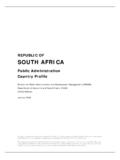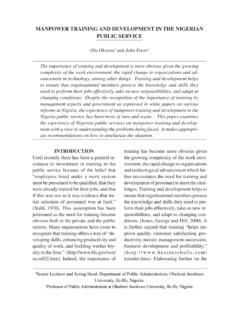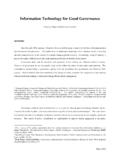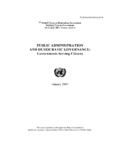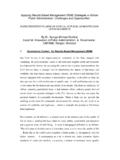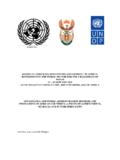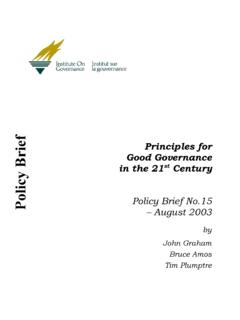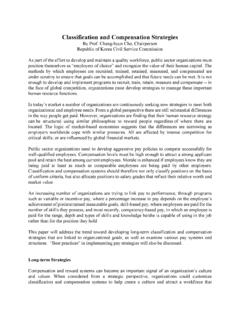Transcription of A COMPREHENSIVE GUIDE FOR SOCIAL IMPACT ASSESSMENT
1 A COMPREHENSIVE GUIDE FOR SOCIAL IMPACT ASSESSMENT 2006 Centre for Good Governance Sl. No. Table of Contents Page No. 1 Introduction 1-9 2 SOCIAL IMPACT ASSESSMENT process 10-19 3 Principals of SOCIAL IMPACT ASSESSMENT 20-24 4 Application of SOCIAL IMPACT ASSESSMENT 25-27 Appendix 1 Sample information format SOCIAL screening 1-2 2 Matrix Relating Project Stage to SOCIAL IMPACT ASSESSMENT Variables 3 3 Format for SOCIAL management plan 4 4 SOCIAL capital format 5-6 5 Public participation techniques 7 6 Sample terms of reference for SOCIAL ASSESSMENT 8-11 A COMPREHENSIVE GUIDE for SOCIAL IMPACT ASSESSMENT Page - 1 Chapter 1: INTRODUCTION BACKGROUND Economic development projects brought innumerable benefits but also had unintended detrimental effects on people and natural resources.
2 Human activities have resulted in the disruption of SOCIAL and communal harmony, the loss of human livelihood and life, the introduction of new diseases, and the destruction of renewable resources. These and other consequences can negate the positive benefits of economic development. SOCIAL impacts are the impacts of developmental interventions on human environment. The impacts of development interventions take different forms. While significant benefits flow in from different development actions, there is also a need to identify and evaluate the negative externalities associated with them. Such impacts not only need to be identified and measured but also need to be managed in such a way that the positive externalities are maximized and the negative externalities are minimized.
3 A balanced development planning takes into account the environmental, SOCIAL and biodiversity impacts of economic development. Environmental IMPACT ASSESSMENT (EIA), SOCIAL IMPACT ASSESSMENT (SIA) and biodiversity IMPACT assessments are some of the methods that aid in the planning and decision making process. These IMPACT assessments help in identifying the likely positive and negative impacts of proposed policy actions, likely trade-offs and synergies, and thus facilitate informed decision-making. Moreover, the need for IMPACT ASSESSMENT stems from the fact that: IMPACT assessments enhance positive and sustainable outcomes associated with project implementation A COMPREHENSIVE GUIDE for SOCIAL IMPACT ASSESSMENT Page - 2 Environmental impacts Biodiversity impacts SOCIAL impacts Economic impacts Project IMPACT They support the integration of SOCIAL and environmental aspects associated with the numerous subprojects into the decision making process.
4 The enhance positive SOCIAL and environmental outcomes; They minimize SOCIAL and environmental impacts as a result of either individual subprojects or their cumulative effects; They protect human health and minimize impacts on cultural property. DEVELOPMENT PROJECTS AND THEIR IMPACTS Sustainable development is increasingly accepted as a fundamental objective for public policy and decision-making. It encompasses the economic, environmental and SOCIAL dimensions of the development process. The growing acceptance of sustainable development as an over-arching policy goal has stimulated interest in assessing the IMPACT of particular interventions on sustainable development at aggregate, sectoral or project levels.
5 Good environmental and SOCIAL management practice is a well-established element of project preparation and implementation. Projects are usually situated within the ambit of specific policies and programmes. The IMPACT of these projects can be economic, SOCIAL and environmental. Figure 1: Multi-dimensional impacts of projects The multidimensional nature of development interventions call for identification of not only potential economic impacts but also potential SOCIAL and A COMPREHENSIVE GUIDE for SOCIAL IMPACT ASSESSMENT Page - 3 environmental impacts (see figure 1). The fallouts of greater urbanization, population growth and globalization can have adverse SOCIAL impacts in the form of increasing poverty, dislocation of vulnerable sections of the society, loss of livelihood etc.
6 Simultaneously, the environment could also be adversely affected viz. increase in air and noise pollution, water pollution, land degradation etc. Even though these IMPACT ASSESSMENT processes are applied in many countries, biodiversity considerations are often inadequately addressed. WHAT ARE IMPACT ASSESSMENTS? SOCIAL problems arise largely due to conflicts between economic development and natural resources. Economic losses and SOCIAL costs from environmental degradation often occur long after the economic benefits of development have been realized. Most often, the development projects provide economic benefits and better living environment, but they also affect local people adversely. SOCIAL IMPACT assessments help in understanding such impacts.
7 IMPACT Assessments in the context of SOCIAL development are: Processes through which the government departments/ agencies can better understand how the socio-cultural, institutional, historical and political contexts influence the SOCIAL development outcomes of specific investment projects and sector policies The means to enhance equity, strengthen SOCIAL inclusion and cohesion, promote transparency and empower the poor and the vulnerable in the design and/or implementation of the project The mechanisms to identify the opportunities, constraints, impacts and SOCIAL risks associated with policy and project design A framework for dialogue on development priorities among SOCIAL groups, civil society, grassroots organizations.
8 Different levels of government and other stakeholders A COMPREHENSIVE GUIDE for SOCIAL IMPACT ASSESSMENT Page - 4 Approaches to identify and mitigate the potential SOCIAL risks, including adverse SOCIAL impacts, of investment projects. It is in this context that SOCIAL IMPACT Assessments (SIAs) assume great relevance. SIA mainly involves the processes of analysing, monitoring and managing the intended and unintended SOCIAL consequences, both positive and negative, of planned interventions (policies, programs, plans, projects) and any SOCIAL change processes invoked by those interventions. These assessments can enable the project implementing authorities to not only identify SOCIAL and environmental impacts, but also to put in place suitable institutional, organizational and project-specific mechanisms to mitigate the adverse effects.
9 They can also aid in bringing about greater SOCIAL inclusion and participation in the design and implementation stages of the project. This GUIDE is aimed at enabling agencies, institutions and government departments to understand and undertake an SIA and, thereby, ensure development interventions subscribe to the overarching principles of sustainable development. WHAT ARE SOCIAL IMPACTS? The Inter-organisational Committee on Guidelines and Principles for SOCIAL ASSESSMENT (1994) (cited in Glasson 2000) defined SOCIAL impacts as the consequences to human populations of any public or private actions that alter the ways in which people live, work, play, relate to one another, organize to meet their needs, and generally cope as members of society.
10 SOCIAL impacts are the people impacts of development actions. SOCIAL IMPACT assessments focus on the human dimension of environments, and seek to identify the impacts on people who benefits and who loses. SIA can help to ensure that the needs and voices of diverse groups and people in a community are taken into account. A COMPREHENSIVE GUIDE for SOCIAL IMPACT ASSESSMENT Page - 5 SOCIAL impacts include changes in people s way of life, their culture, community, political systems, environment, health and wellbeing, their personal and property rights and their fears and aspirations. Examples of projects with significant SOCIAL impacts include: landfill and hazardous waste disposal sites (perceived health risks, loss of amenity); power and industrial plants (community stress from influx of work force, pressure on infrastructure); dams and reservoirs (lifestyle disruption resulting from relocation, land use alteration or long lead time to full impoundment); and roads and linear developments (dislocation of activity networks and relationships).
